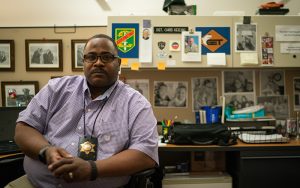- Slug: BC-CNS-Hate and Latinos. 3,465 words.
- Photos and captions below.
- Video here.
By BRENDAN CAMPBELL, ANGEL MENDOZA and TESSA DIESTEL
News21
EUGENE, Oregon – Sergio Reyes and two other Mexican immigrants were busy landscaping at their worksite in early 2018 when they were accosted by a man hurling racial epithets and threatening to cut off the head of one of them.
“It doesn’t matter if I become an American citizen,” Reyes said. “If your skin color is not white and your English is not perfect, you don’t blend. Bottom line.”
The man’s later acquittal of all charges was seen by the three men as yet another in a long string of injustices they, and many immigrants to America, say they experience regularly.
More than one in five suspected hate crimes victimized Latinos, according to a News21 analysis of responses to the National Crime Victimization Survey data from 2012 to 2016.
Hate incidents targeting Latinos and immigrants often go beyond name-calling and intimidation. Victims and advocates also say they are too often the targets of assault, robberies and even murder.
As targeting of their communities is on the rise, Latinos and immigrants are increasingly fearful of reporting racially motivated crimes and incidents to law enforcement, according to victims, experts and advocates interviewed by News21 in Florida, Oregon, California and Texas.
“In immigrant communities, the fear is palpable,” said Monica Bauer, director of Hispanic affairs at the Anti-Defamation League. “It’s so much fear that I think the word doesn’t really convey. It’s almost terrified, like it’s beyond fear. It’s paralyzing fear.”
Latino victims made up only 11 percent of racial-bias crimes reported to the FBI in 2016, but studies have shown the FBI substantially undercounts such crimes. Of 15,254 agencies providing statistics to the FBI in 2016, 88 percent reported zero hate crimes.
Hate-crime experts, victims and witnesses told News21 that two major factors have exacerbated the problem recently: a perceived climate of anti-immigrant animosity encouraged by the election of President Donald Trump; and fears of reporting to authorities, especially among undocumented immigrants who fear deportation.
Nationwide, a 2018 report by the Center for the Study of Hate and Extremism at California State University, San Bernardino, found 34 anti-Latino hate crimes were reported in America’s largest cities in the first two weeks after the 2016 election, a 176 percent increase over the year-to-date daily average.
“Post election, I could tell that there was a change,” said Pricila Garcia, 20, the daughter of Mexican immigrants living in Cleburne, Texas. “People became a little more brave with their words, especially when it came to hateful things that they said.”
The word “emboldened” came up repeatedly in interviews with victims and advocates who say immigrants, particularly those from Mexico and other Latin American countries, are being singled out with an impunity unique to this political moment.
But U.S. Rep. Ruben Gallego, D-Ariz., said anti-immigrant and anti-Latino sentiment started merging after the 9/11 terrorist attacks, and today they’re one and the same.
“By 2010, there were Latino families in Arizona that were being told to go back to their country, to go back to Mexico – these are people that have lived in Arizona for generations,” Gallego said.
Gallego, who was in the Arizona Legislature in 2010, said he was receiving death threats from white supremacists for trying to fight anti-immigrant legislation.
A 2018 report by Janice Iwama, a sociology researcher and professor at the University of Massachusetts in Boston, said the doubling of the immigrant population in the U.S. from 1990 to 2015, to more than 43 million, prompted anti-immigrant legislation at the state and federal levels.
Iwama’s study also said there is “the common misperception that all Latinos are immigrants.” In fact, two-thirds of the 57 million Hispanics living in the U.S. in 2015 were natural-born citizens, according to a 2017 Pew Research Center study.
Advocacy groups, law enforcement and government officials across the country say they’re trying to educate Latino community members and police to properly and sensitively identify and document hate incidents.
The Anti-Defamation League has been working with Mexican consulates in the U.S. to create an alternative method for vulnerable immigrant communities to report hate crimes. ADL’s Bauer said the league will create a new database from these reports to share with law enforcement. To date, the ADL has trained hundreds of people in consulates across 23 states to understand hate crimes and anti-immigrant extremism.
Detective Christopher Keeling, coordinator of the hate crime unit of the Los Angeles County Sheriff’s Department, said the department is reaching out to immigrant communities, emphasizing that hate-crime victims shouldn’t fear consequences for their documentation status, and that officers “will help you stay here.”
The California State Auditor also has recommended law enforcement better educate “specific targeted communities, such as Muslims and immigrants” on hate crime, something the Los Angeles sheriff’s department already is doing.
“They have to first see us as an equal, as a friend, as a partner. And that takes time,” Keeling said. “We can’t protect what we don’t know.”
Eugene: A city striving for inclusion against rising tide of hate
In picturesque Eugene, home to the University of Oregon, the city is building strategies and resources to protect its residents, but the experiences of Latinos show that change comes slowly.
“Sadly, hate-motivated crimes are a growing phenomenon throughout Oregon,” Oregon Attorney General Ellen Rosenblum said in a May 23 news release announcing the formation of a task force to tackle the problem.
The Southern Poverty Law Center, an advocacy group in Montgomery, Alabama, that tracks hate and bigotry, has identified at least 10 white supremacist or nationalist groups in Oregon. In addition, Oregonians for Immigration Reform, has an initiative on the November ballot to reverse Oregon’s three-decade-old sanctuary law, which prevents local governments from using resources to enforce federal immigration law.
An annual report from Eugene’s Office of Human Rights and Neighborhood Involvement said hate crimes nearly doubled from to 44 to 87 in 2017. Three violent anti-Latino attacks were reported in that time. The report noted, however, that some of this increase may be in response to city programs encouraging crime reporting.
One event on Jan. 16, which Reyes said he witnessed, illustrates the complicated dynamics of such situations.
Reyes, 39, recalled that he and his landscaping crew were working outside a shopping center in Eugene when a man later identified as Brandon Scott Berry, 27, approached and began yelling.
“I’m going to cut your head off and nobody will care because I’m white and you’re not!” Reyes remembered him saying.
A police report said Berry shoved Edu Martinez, 28, multiple times, and pushed his cellphone camera into the face of Victor Herrera, 48. Herrera slapped Berry, knocking his phone out of his hand.
“He said that he was going to get us in trouble,” Martinez told News21, “that we did not have any rights here … that we didn’t belong in this country. And then he called the police.”
The responding officer determined there was probable cause to arrest Berry for intimidation, according to a police report. “Berry’s verbal insults, conduct, and threat to cut off Victor’s head was a serious threat to cause serious physical injury and made in a heated, racially motivated manner,” the officer wrote.
Police referred Martinez to the city’s Office of Human Rights, which brought in Centro Latino Americano, a nonprofit providing services to the immigrant community in Lane County, Oregon, to support the three landscapers and their families.
Prosecutors charged Berry with three counts: menacing, and two counts of intimidation.
On May 31 in Eugene Municipal Court, a one-day trial resulted in a jury finding Berry not guilty on all counts, court records show.
“It was horrible,” Reyes said. “It was a horrible thing to go through, you know.” He blamed the verdict on bias by the jury, which he said was “all white.”
Trevor Whitbread, assistant director for Centro Latino Americano, who sat in on the trial, agreed.
“A lot of white community members are still not familiar with issues of hate,” he said. “I think the jury was not prepared to be as receptive as other groups of people could be.”
Berry saw the situation differently.
“(Martinez) was calling me gringo and all sorts of stuff, trying to instigate me to fight him,” Berry said in a telephone interview. In response, he called Martinez a beaner, which also was noted in the police report.
Berry denied using intimidating or threatening language, particularly to cut off Herrera’s head.
Berry said he felt intimidated in the courtroom, noting there were “a lot of cops” in the courtroom that day.
“You could tell there was a bias, and the reason why this cop arrested me was he has a prejudice against me from the start,” Berry said. He said the arresting officer may know him because of past incidents and his recognizable tattoos, adding that he’s been harassed a lot by Eugene police.
Berry also credited his attorney, John Kolego, for persuading the jury and the judge to not hold any bias against him. When bias is removed, he said, the “justice system works every time.”
As an immigrant, Reyes said he has faced many injustices over the years, including harassment, abuse and wage theft by employers. One refused to pay him, put a knife to his throat and told him to go back to Mexico, Reyes said.
Mayor Lucy Vinis said Eugene is taking steps to protect Latinos, who represent 7 percent of the population. She pointed to the work of the city’s Human Rights Office and its police auditor, who reviews the department’s handling of sensitive cases, as well as a 2017 ordinance preventing city officials from sharing documentation information with federal agents.
Herrera, Martinez and Reyes agreed they felt support from police and their community, but they were disappointed, if unsurprised, they didn’t get justice.
Outside the shopping center that day, Reyes said, he recalled Berry telling him: “I have more rights than you do and I’ll never get in trouble because I’m white and you’re not.
“You know what happened? We went to court and he’s a free man right now,” Reyes said. “He was right.”
Cleburne: Daughters of immigrants grapple with uncertainty
Train tracks bisect Cleburne, a sparse, rural town in north Texas, named in honor of a Confederate general. Its population is 66 percent white and 28 percent Hispanic, according to U.S. Census data.
“On one side,” Pricila Garcia said, “you have the rental houses that are falling apart, and it’s nothing but minorities, and on the nicer side of town you have the kids that have the nice houses, the pools, the big yards.”
The tracks symbolize Cleburne’s identity as an agricultural railroad center. But Garcia, 20, said they mark a deep, insidious racial divide in a town where everyone knows each other but few know the struggles of immigrants.
Garcia, a daughter of Mexican immigrants, said she has experienced firsthand the fear and isolation that many immigrants feel with the justice system in America today.
“I really truly believe that the majority of us are victims of (hate) crimes,” she said. “We’re told not to draw any unnecessary attention to ourselves – even if you get robbed or exploited or you’re in danger.”
Cleburne is a hour drive south from Dallas, and lies in an area of north Texas that saw a 71 percent increase in arrests by U.S. Immigration and Customs Enforcement from 2016 to ’17 – second only to Florida, according to Pew Research Center.
Garcia and Blanca Reyes, who also is 20 and the daughter of Mexican immigrants, said they and their peers constantly fear losing their parents to deportation if they report crimes or even apply, as citizens, for college student aid.
“Less involvement with state, local government the better because you’re just trying not to give any red flags off,” Garcia said.
She said her family is often the target of hate speech, and she recalled how her mother was called “a stupid (expletive) Mexican” at a store parking lot.
“Words make you feel inferior, subhuman – almost like you’re not worthy enough to be here,” she said. “It’s never really physical violence, but it’s always aggression. It’s always people yelling in your face … you get called disgusting names.”
Since the 2016 presidential election, she said, many immigrant families, including her own, are in a state of fearful silence. One of the worst conversations of her life was with her parents after the election.
“They sat me down and said, ‘Hey, we’re putting you as the main on all of our bank accounts,” she recalled tearfully. “If anything happens to us, sell our stuff. The furniture, our clothes, everything, go sell everything, go live with your uncle and take care of your brother and your sister.”
She said she’s became even more concerned after Trump administration began to detain and separate immigrant families at the Arizona border.
Reyes said normalization of anti-Latino rhetoric even made her afraid to call out her former manager for saying racist things. She declined to identify her workplace but said she quit after dealing with several racist incidents over a span of months.
“I would get anxiety attacks every single time I had to go to work,” she said.
On July 4, Reyes chose to watch fireworks from outside her home, rather than joining the city-sponsored festivities near Lake Pat Cleburne.
“It’s really hard to celebrate a holiday where we’re supposed to celebrate our country when our country really isn’t celebrating our existence,” she said.
Jupiter: Culture of hate preys on Florida’s ‘invisible’ Guatemalans
Florida, the third most populous state, where one in five – about 4 million – are immigrants, has one of the worst records in the nation for reporting hate crimes, according to experts. The Florida Attorney General’s Office reported just 52 hate crimes related to race or ethnicity in 2016.
“It’s a very populous state with a very large percentage of the population that has Latin roots of some kind,” Shively said. “Really miniscule numbers.”
In Palm Beach County, one case broke through the reporting blackout, but only for its extreme nature, said Bauer of the Anti-Defamation League. The case, she said, showed the culture of hate targeting the isolated, almost invisible, Guatemalan immigrant community.
On April 18, 2015, Onésimo Marcelino López-Ramos, 18, was confronted outside his home in Jupiter by three men who beat him with a rock, a metal rod, and an ax handle – crushing his skull, prosecutors said. Assistant State Attorney Jill Richstone said the men were “Guat hunting,” referring to a practice of robbing and assaulting Guatemalans walking home on paydays.
“The reason we know what happened to Onésimo is because they killed him,” Bauer said. “And my fear is that things are happening every single day, all the time, without us hearing about them because people are so terrified to come forward.”
In May, one of three defendants, David Harris, 22, was convicted in a county court of first-degree murder, as well as a hate-crime charge, and sentenced to life in prison without the possibility of parole.
Trial is set to begin Nov. 5 for co-defendant Austin Taggart, 22. His brother, Jesse Harris, 21, will be tried later.
Even as Jupiter police pushed for hate-crime charges in López-Ramos’s case, the city did not report any hate crimes in 2015, according to FBI statistics.
An analysis by ProPublica, a nonprofit journalism organization in New York, showed Florida had four of the Top-10 largest cities in the country that did not report significantly, or at all, hate crimes to the FBI in 2016. The largest, Jacksonville, has not reported a single hate incident since 2014.
Tim Gamwell, assistant executive director of the Guatemalan-Maya Center in Lake Worth, near Jupiter, said the decision by prosecutors in the López-Ramos case to pursue hate-crime charges was pivotal.
“It’s an acknowledgement that this community deserves protection, deserves recognition,” he said. “It’s a very difficult thing to report a crime in Palm Beach County if you’re an immigrant.”
Gamwell said López-Ramos’s murder should serve as a wake-up call for the community, although he said there needs to be more focus on the culture that gave rise to “Guat hunting” in the first place.
“People used to call them walking ATMs” because Guatemalans are often paid in cash and don’t have access to banking, said Suzanne Cordero, executive director of El Sol, a community center in Jupiter that hosted a memorial for López-Ramos.
Maya from Guatemala have fled to south Florida since the 1960s, at the beginning of the country’s four-decade-long civil war in which 150,000 indigenous Maya were “disappeared” or killed by government forces, according to the Center for Justice and Accountability.
Maya sustain much of the local agricultural sector, but cultural factors and language barriers – many only speak one of several Mayan dialects, rather than Spanish or English – have kept the community isolated, even invisible, Gamwell said.
Esperanza, an undocumented Guatemalan who preferred not to use her real name, said she immigrated to Florida in 1997, and has feared interaction with authorities since. Florida had a 76 percent increase in ICE arrests from 2016-17 – the highest in the nation, according to a Pew Research study.
Gamwell said Esperanza, a client of the Guatemalan-Maya Center, drives her kids less than a mile to school every day, and constantly fears being stopped, deported and separated from her children.
“Sometimes the police are behind me, I say, ‘Please God, put his eyes on the side,’” Esperanza said. “Maybe they catch Mom.”
Esperanza has forged a new life away from the poverty and violence in Guatemala, but she said she’s harassed everywhere in her daily life, whether because she has four children or because of the language she speaks.
After the murder of López-Ramos, Jupiter police reached out to the Guatemalan community.
Cordero of El Sol community center, said former Police Chief Frank Kitzerow gave an important and emotional address at the center shortly after the incident, and the police work closely with the center and its clients, even playing regular soccer matches there.
Los Angeles: Violence follows most vulnerable Latinas
In California, the state with the largest Latino population – more than 15 million – reported that incidents of anti-Latino bias increased from 83 in 2016 to 126 in 2017, according to the California Department of Justice’s annual hate crime report, released in July.
In Los Angeles County, violent hate crimes targeting transgender Latinas accounted for 20 of the 31 crimes motivated by gender identity, according to the 2016 Commission on Human Relations report. Ninety-seven percent of anti-transgender incidents were violent crimes, such as simple and aggravated assaults, a proportion higher than for any other group the commission tracks, including Latinos. And the actual number of hate crimes targeting trans Latinas may be higher, according to Marshall Wong, the principal author of the report.
Trans Latinas are doubly reluctant to call police, experts say. Latinos overall fear reporting because of possible deportation, and trans Latinas also say law enforcement rarely takes crimes against their community seriously, often blaming them for their own victimization.
Robin Toma, the Commission on Human Relation’s executive director, said its 2017 hate crime report featured a trans Latina’s story to highlight the exceptional threat to this group of Latinos.
In January, Viccky Gutierrez, a trans immigrant from Honduras, died after she was stabbed multiple times in the Pico-Union neighborhood of Los Angeles. Her home was set ablaze, leaving her body unrecognizable. Kevyn Ramirez pleaded not guilty to first-degree murder and two counts of arson, and awaits trial in Los Angeles County Superior Court, according to court records.
Toma said, “There is every reason to believe that it was hate motivated.”
Those who knew Gutierrez say they have no doubt she was killed for who she was, and they hold out hope for a conviction with a hate-crime penalty enhancement.
“I was born and raised in Mexico and came here trying to find a better way of life and seek the American dream, only to find the American nightmare,” said Bamby Salcedo, founder and CEO of the TransLatin@ Coalition, a nonprofit that provides resources for trans Latinas, many of whom are immigrants. Salcedo said Gutierrez was a sister to her, who “was one of our clients, but also an up-and-coming leader” of the nonprofit. Her murder was hate motivated, Salcedo said.
“Stabbing someone, obviously, is not good, but the fact that he went the extra mile to make sure that there was no way for us to recognize her ¬– it was very intentional,” Salcedo said. “When we walk out into the streets, violence follows us everywhere we go – whether it’s because we’re Latinas, whether it’s because we’re immigrants, whether it’s because we’re trans, or maybe because we’re all of those things.”
This story was reported in partnership with ProPublica’s Documenting Hate Project, which is collecting reports about hate crimes and bias incidents. If you’ve been a victim or a witness, tell us your story here.
For more stories from Cronkite News, visit cronkitenews.azpbs.org.
This report is part of the “Hate in America” project produced by the Carnegie-Knight News21 initiative, a national investigative reporting project by top college journalism students and recent graduates from across the country and headquartered at the Walter Cronkite School of Journalism and Mass Communication at Arizona State University.
^_=






